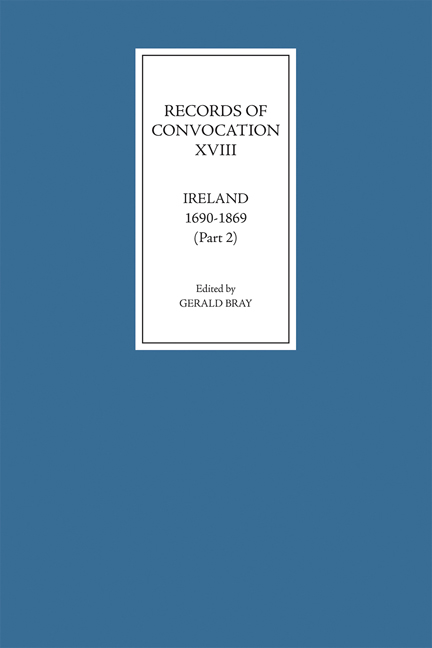Book contents
- Frontmatter
- Content
- Abbreviations
- Anne (1702-14)
- George I (1714-27)
- George II (1727-60)
- George III (1760-1820)
- George IV (1820-30)
- William IV (1830-7)
- Victoria (1837-1901)
- A table of proportions to be paid by the archbishops and bishops
- Prolocutors of the Irish national convocation, 1615-1869
- Membership of the convocation of the Church of Ireland
- Irish bishops in the house of lords, 1801-70
- The Nova Taxatio of Pope Nicholas IV in Ireland
- The Province of Armagh
- The Province of Cashel
- The Province of Dublin
- The Province of Tuam
- The Valor in Hibernia
- Irish clerical taxation
- Guide to source material
- The Irish convocation controversy, 1708-11
- Index of sources
- Index of references
- Index of names and places
- Index of subjects
- Bibliography
Irish bishops in the house of lords, 1801-70
Published online by Cambridge University Press: 11 January 2024
- Frontmatter
- Content
- Abbreviations
- Anne (1702-14)
- George I (1714-27)
- George II (1727-60)
- George III (1760-1820)
- George IV (1820-30)
- William IV (1830-7)
- Victoria (1837-1901)
- A table of proportions to be paid by the archbishops and bishops
- Prolocutors of the Irish national convocation, 1615-1869
- Membership of the convocation of the Church of Ireland
- Irish bishops in the house of lords, 1801-70
- The Nova Taxatio of Pope Nicholas IV in Ireland
- The Province of Armagh
- The Province of Cashel
- The Province of Dublin
- The Province of Tuam
- The Valor in Hibernia
- Irish clerical taxation
- Guide to source material
- The Irish convocation controversy, 1708-11
- Index of sources
- Index of references
- Index of names and places
- Index of subjects
- Bibliography
Summary
Under the terms of the act of union in 1800, bishops of the Church of Ireland were entitled to sit in the house of lords on a rotation basis. The four archbishops served in succession, as did three diocesan bishops at each session of the United Kingdom parliament. Owing to some confusion, the Irish bishops did not take their seats until 1803, at which time the rotation was reckoned to have started with the second UK parliament (in the case of the archbishops) but with the first in the case of the bishops. The system continued unaltered until the suppression of two archbishoprics and ten bishoprics in 1834. The changes took effect at the death of the incumbent, a process which was not finally completed until 1854, though in that year the bishop ofTuam became a lay peer by inheritance and Tuam was therefore passed over until after his death in 1866. The overall representation of the bishops remained unchanged, which meant that individual prelates were summoned more frequently. Attendance was very poor in the initial years, but it improved somewhat after 1834, perhaps because of better transport links as much as anything else. After the passage of the disestablishment bill in July 1869, the Irish bishops no longer attended the sessions, though they were entitled to do so until the end of 1870.
- Type
- Chapter
- Information
- Records of Convocation , pp. 251 - 254Publisher: Boydell & BrewerFirst published in: 2024

